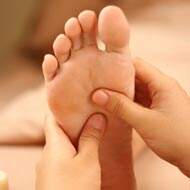2 Pressure Points to Say Goodbye to Menstrual Cramps
Most women dread that time of the month when the periods are on. Periods can bring with it mood swings, menstrual cramps, and other symptoms. It may not be the case for all women, but most women have had some characteristic symptoms of periods during their lifetime. Menstrual cramping refers to pain in the lower-abdominal area, that are sharp and or of aching nature.
Some amount of pain is normal during menstruation however excessive pain is not, and a doctor should be consulted if the pain is so severe that it interferes with day to day activities. Menstrual cramps usually occur during the first few days when periods begin. The pain is speculated to be a result of increased activity of the prostaglandin hormone in healthy young women.
Severe cramps that occur during periods in older women could possibly be the sign of fibroids, sexually transmitted infections, pelvic inflammatory disease, endometriosis, intrauterine devices, premenstrual syndrome, or anxiety and stress. So what can one do to reduce menstrual cramps and symptoms of PMS? Apart from traditional medicines, acupressure has been gaining popularity for its role in alleviating menstrual cramps by massaging two pressure points on the body.
Acupressure is a therapy which originated in ancient China. It is based on the concept on acupoints and deep massage therapy of these points. These acupoints are located along energy pathways or meridians throughout the body. It is believed that there are 12 major acupoints that link specific organs or a network of organs.These channels or pathways have vital energy (Qi) flowing through it. The specific points begin at the fingertips, connect to the brain, and then to the organ related to the meridian. Obstruction or blockage of one or more of the pathways can cause imbalance the flow of energy and result in illnesses.
The therapy works by acupressure practitioners using their fingers, elbows, feet and palms to apply pressure on the acupoints along the body’s meridians. It is performed with the client being completely but comfortably clothed, lying down.
Stomach 36
Stomach 36 is a pressure point that is located on the bump of a bone about one inch below your knee. This particular bump is called fibial tuberosity. Stomach 36 is in level with the bottom of the bump. You can find this spot by measuring one thumb width towards the outside of your leg. Pressing strongly and deeply on this point can help reduce pain and cramping. If the muscles in the area of ST 36 are, weak then practice gentle rubbing. It is known as the superstar of all acupressure points as it also assists in strengthening the flow of energy (Qi) and blood, improves digestion, decreases fatigue, and enhances general health.
Spleen 6
Spleen 6 is another important acupressure point that is used to alleviate symptoms of urological and pelvic disorder, menstrual cramps, and helps with insomnia. This point is found on the inside of the leg, just above the ankle. Place four fingers just above the ankles to find the exact spot. Massage the area by applying deep pressure for four to five seconds. This should not be used during pregnancy as it may induce labor.
60 to 93 % of adolescent girls are affected by menstrual cramps that are not associated with any other pelvic issues. Sometimes, these pains can be accompanied by back pain, dizziness, diarrhea, headaches, fatigue, vomiting and nausea. Typical treatment will involve exercising, pain-relieving medication, and heat compression. But more and more women are also exploring alternative or complimentary therapies in conjunction with traditional medicine to overcome and get relief from menstrual symptoms. Studies conducted have shown evidence of acupressure working successfully to relieve pain, improve digestion, help with depression and anxiety, and enhancing energy levels.
Read more articles from the General Discussion Category.
 Find Pose
Find Pose

